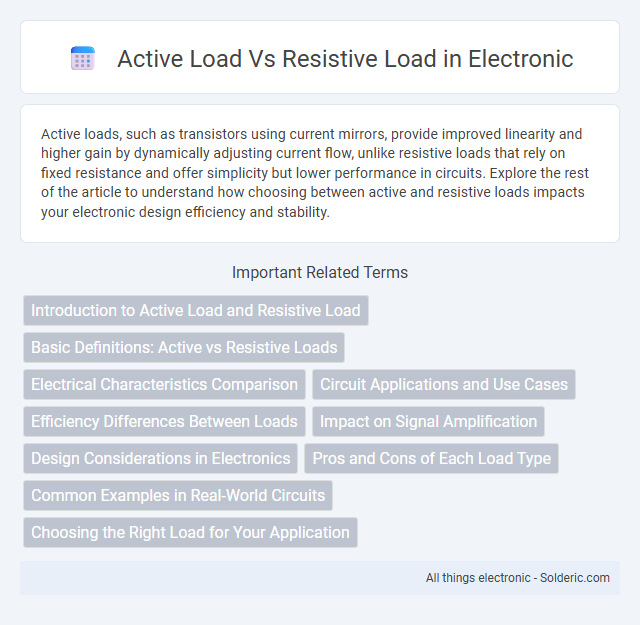Active loads, such as transistors using current mirrors, provide improved linearity and higher gain by dynamically adjusting current flow, unlike resistive loads that rely on fixed resistance and offer simplicity but lower performance in circuits. Explore the rest of the article to understand how choosing between active and resistive loads impacts your electronic design efficiency and stability.
Comparison Table
| Feature | Active Load | Resistive Load |
|---|---|---|
| Definition | Electronic load using transistors to simulate resistance | Physical resistor providing fixed resistance |
| Power Efficiency | High efficiency with adjustable power dissipation | Lower efficiency due to fixed power dissipation |
| Control | Adjustable load current or voltage dynamically | Constant resistance; no dynamic adjustment |
| Heat Dissipation | Requires active cooling at high power | Generates heat proportional to power; may need heatsinks |
| Applications | Battery testing, semiconductor characterization | Basic circuit testing, fixed load scenarios |
| Cost | Higher initial cost due to complexity | Lower cost and simpler design |
| Accuracy | High accuracy with programmable loads | Depends on resistor tolerance; less precise |
Introduction to Active Load and Resistive Load
Active loads use transistors or other electronic components to simulate resistance with dynamic behavior, improving circuit performance and linearity in applications such as amplifiers. Resistive loads, composed of fixed resistors, provide a constant resistance, dissipating energy as heat and offering predictable, stable characteristics for measuring and testing. Understanding your circuit's requirements helps determine whether an active load's precision or a resistive load's simplicity best suits your application.
Basic Definitions: Active vs Resistive Loads
Active loads are electronic components or circuits that supply energy or maintain current flow, often incorporating transistors or operational amplifiers to simulate resistance with improved stability and linearity. Resistive loads consist of passive resistors that convert electrical energy directly into heat, providing a constant resistance regardless of voltage or current changes. Unlike resistive loads, active loads can dynamically adjust their impedance to maintain desired operating conditions in testing and circuit simulation.
Electrical Characteristics Comparison
Active loads exhibit variable impedance that adjusts based on input signals, enabling improved linearity and gain in amplifier circuits compared to fixed-value resistive loads. Resistive loads maintain a constant resistance regardless of voltage or current changes, resulting in predictable but less efficient performance in dynamic applications. Active loads can emulate high resistance with low voltage drop, enhancing signal amplification and bandwidth, whereas resistive loads consume more power and generate heat due to fixed resistance values.
Circuit Applications and Use Cases
Active loads, commonly implemented with transistors, offer high output impedance and improved linearity, making them ideal for amplifiers, current mirrors, and analog signal processing circuits. Resistive loads, composed of passive components like resistors, provide simplicity and stability, often used in basic voltage dividers, biasing networks, and power dissipation elements. Your choice between the two depends on the specific circuit application, where active loads enhance performance in high-frequency or precision designs, while resistive loads ensure reliability and straightforward implementation.
Efficiency Differences Between Loads
Active loads utilize controlled current or voltage sources that adapt dynamically, resulting in higher efficiency by minimizing power dissipation compared to resistive loads, which convert electrical energy directly into heat. Your system's performance can improve significantly with active loads, as they reduce wasted energy and maintain stable operating levels under varying conditions. Efficiency in circuits is enhanced by active loads through precise control, whereas resistive loads inherently cause greater energy loss due to constant resistance and heat generation.
Impact on Signal Amplification
Active loads significantly enhance signal amplification by providing higher gain and improved linearity compared to resistive loads. Unlike resistive loads, active loads use transistors to maintain a constant current, minimizing voltage variation and boosting overall amplifier efficiency. This results in greater output swing and better frequency response, critical for high-performance analog circuits.
Design Considerations in Electronics
Active load design in electronics offers greater linearity and improved gain compared to resistive loads, which are simpler but suffer from fixed voltage drops and power loss. Your circuit's performance can be enhanced by choosing active loads like current mirrors or transistors for precise control of current and improved dynamic range. Resistive loads remain advantageous for low-cost, straightforward designs where power efficiency and temperature stability are less critical.
Pros and Cons of Each Load Type
Active loads offer superior linearity and higher gain in amplifier circuits, which enhances overall performance and efficiency, though they can introduce increased complexity and power consumption. Resistive loads provide simplicity, stability, and predictable behavior with minimal noise, but they often result in lower gain and reduced power efficiency. Each load type's suitability largely depends on the specific application requirements, balancing trade-offs between performance and design complexity.
Common Examples in Real-World Circuits
Active loads, commonly represented by transistors or operational amplifiers, are frequently used in differential amplifiers and current mirrors to improve gain and linearity in analog circuits. Resistive loads, such as fixed resistors or potentiometers, are typical in simple voltage dividers, biasing networks, and LED current limiting applications. The choice between active and resistive loads depends on desired performance metrics like gain, power consumption, and circuit complexity in real-world electronic designs.
Choosing the Right Load for Your Application
Selecting the right load for your application depends on the desired performance and power efficiency; active loads, which are circuit elements that mimic resistive behavior using transistors, offer precise current control and improved linearity in testing environments. Resistive loads, consisting of physical resistors, provide simplicity and reliability in power dissipation without the complexity of active components. For applications requiring dynamic response and accurate simulation of real-world conditions, active loads outperform resistive loads, especially in battery testing and power supply characterization.
active load vs resistive load Infographic

 solderic.com
solderic.com